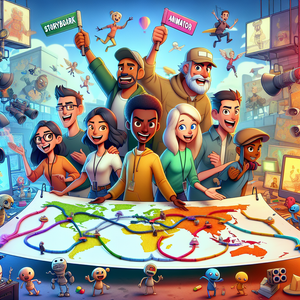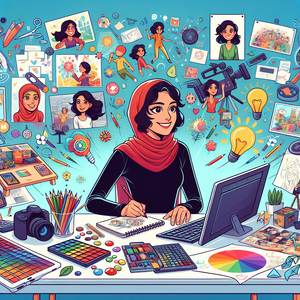
Navigating the Animation Landscape: A Complete Guide to Careers, Skills, and Opportunities
The animation industry is a vibrant and ever-evolving field that presents a multitude of career paths across film, television, and gaming. As the appetite for captivating animated content continues to grow, the demand for skilled professionals in various specialized roles is also on the rise. This guide aims to illuminate the diverse job titles available in animation, outline the essential skills and educational requirements for each role, and highlight how these positions contribute to the industry as a whole.
Job Summaries:
Animator:
- Animators are the heartbeat of animated storytelling, bringing characters and scenes to life through movement.
- They utilize both traditional methods and modern digital software, such as Adobe Animate, Blender, or Maya.
- A strong artistic foundation, a degree in animation or related fields, and a robust portfolio showcasing their work are essential.
- Meeting deadlines and collaborating effectively are key components of their role.
Storyboard Artist:
- Responsible for visualizing scripts
- Storyboard artists break down scenes into panels
- Mapping out the narrative flow
- Strong drawing skills are crucial
- A deep understanding of cinematography is crucial
- A degree in art or animation is beneficial
- A compelling portfolio is necessary to demonstrate abilities
Character Designer:
- Character designers craft the unique look and personality of animated figures.
- They need a solid grasp of anatomy and color theory.
- Proficiency in design software like Photoshop and Illustrator is essential.
- A degree in graphic design or illustration is typically required.
- A strong portfolio is also necessary.
3D Modeler:
- 3D modelers create realistic three-dimensional representations of characters and environments using software like Maya or ZBrush.
- A strong portfolio showcasing modeling skills is essential.
- A degree in animation or digital art is important.
Visual Effects (VFX) Artist:
- Enhancing live-action or animated scenes with digital effects is the primary focus of VFX artists.
- Mastery of software such as After Effects, Nuke, or Houdini is critical.
- A relevant degree and a strong portfolio demonstrating previous work are often necessary.
Art Director (Animation):
- Art directors shape the visual style of animation projects.
- Ensuring alignment with the director's vision.
- Strong leadership is essential.
- A deep understanding of design principles is essential.
- Extensive industry experience is required.
Lighting Artist:
- Lighting artists set the mood and atmosphere for animated scenes.
- They require strong collaboration with modelers and animators.
- Proficiency in color theory is important.
- Familiarity with software like Maya or 3ds Max is important.
Compositor:
- Compositors blend various visual elements into a cohesive scene.
- They necessitate a keen eye for detail.
- Proficiency in compositing software like Nuke or After Effects is required.
Texture Artist:
- Texture artists create surface textures for 3D models, enhancing the realism of animated visuals.
- Attention to detail and proficiency in tools like Substance Painter are crucial.
Animation Technical Director (TD):
- Animation TDs manage technical aspects of production
- Require a background in computer science or animation
- Proficiency in scripting languages like Python
Layout Artist:
- Layout artists design the composition of scenes
- Layout artists necessitate strong drawing skills
- Layout artists require familiarity with design software
Rigging Artist:
- Rigging artists develop skeletal structures for 3D models.
- Enable realistic movement.
- Require technical skills.
- Proficiency in rigging software.
Production Assistant:
- As entry-level support for various departments
- Production assistants handle administrative tasks
- Require strong organizational skills
Game Animator:
- Game animators create animations specifically for video games
- Proficiency in animation software is necessary
- Knowledge of game engines like Unity or Unreal Engine is required
Animation Producer:
- Animation producers oversee the production process
- Require strong leadership skills
- Require project management skills
Special Effects Artist (SFX Artist):
- SFX artists create practical effects for animations.
- They need a solid understanding of physics.
- They require proficiency in relevant software.
Animation Writer:
- Writers craft engaging scripts and storylines
- Requiring strong writing skills
- Requiring creativity
Digital Illustrator:
- Digital illustrators produce artwork using digital tools
- Necessitating strong drawing skills
- Proficiency in software like Adobe Illustrator
Sound Designer:
- Sound designers create and manipulate audio elements
- Require technical skills in audio editing
- Understanding of sound design principles
Animation Researcher:
- Researchers gather information to inform the creative process
- Requiring strong research and analytical skills
By delving into these varied career paths and understanding the skills required for each, individuals can better navigate their journey within the animation industry. Whether you’re just starting or looking to advance your career, the world of animation offers boundless possibilities for creativity and innovation.
Explore More Jobs

